National Awards in IndiaAs the name suggests, the national awards of India are awarded by the Govt. of India to people for their exceptional service or performance in different fields irrespective of their age, caste, occupation, religion, etc. These awards are divided into different categories that include Civilian Awards, Gallantry awards, Sports awards, Literature awards, and Peace and leadership awards. 1. Civilian Awards:These awards are further divided into four types: i) Bharat Ratna:It the most prestigious civilian award in India given in the field of art, literature, science, and public services for exceptional service or performance of the highest order. However, from December 2011 onwards, it was also started being given in any field of human endeavour. Accordingly, the sports category was also included. Thus Sachin Tendulkar became eligible and got the Bharat Ratna and became the youngest receiver and first sportsperson to receive this award. There is no official process to nominate people for this award. It is the Prime Minister of India who has the authority to nominate and recommend the name of people to the President of India. However, only three names can be nominated for this award by the Prime Minister without any discrimination based on race, position, occupation, etc. It was introduced on 2 January 1954 by Rajendra Prasad, the then prime minister of India. In the beginning, only the living people were being nominated for this award. Later it was also started being given posthumously and Shri. Lal Bahadur Shastri was the first person to be awarded Bharat Ratna after death (posthumously). Design of Bharat Ratna: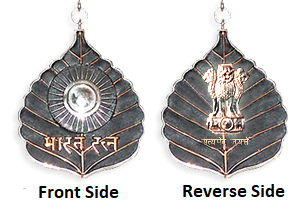
It looks like a people leaf, which is made of toned bronze. It measures 5.8 cm in length, 4.7 cm in breadth, and has a thickness of 3.3 mm. The front side of this medal displays the words "Bharat Ratna" which are written in devnagri (Hindi) language, and it is also embossed with an image of the sun that measures 1.6 cm in diameter. On its opposite side, you can see the state emblem and motto. The rim, sun, and emblem of India are made up of platinum. The medal is worn around the neck while it is awarded to a recipient, so a two-inch ribbon is attached to the medal. The first recipients to receive Bharat Ratna include C. Rajagopalachari (a politician), Chandrasekhar Venkata Raman (a scientist), and Sarvepalli Radhakrishnan (a philosopher). ii) Padma Vibhushan:It is the second-highest civilian award in India, introduced on 2 January 1954. It is given for extraordinary performance or service in the areas of art, science, public service, including the services of employees of the government sector. Design of Padma Vibhushan: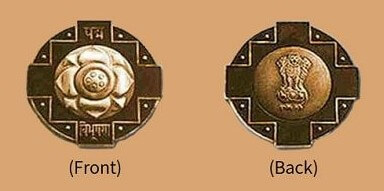
This circular-shaped award is made of bronze. Its diameter is 4.4 cm, with a thickness of 0.6 mm. The medal has a geometric pattern. The word Padma is printed on its front side in devnagri script (Hindi) on the upper portion, and the word "Vibhushan" is marked on the lower portion on the front side. There is a lotus flower between these two words in the centre. On its reverse side, you can see the national emblem on which "Satya Meva Jayate" has been imprinted. The inscriptions, geometric pattern, and boundaries are made up of bronze, whereas the rest of the embossing is made up of white gold. A dark purple coloured ribbon is attached to the award as it is also worn around the neck. iii) Padma Bhushan:Padma Bhushan is the third-highest civilian award conferred by Indian Govt. for exceptional services in any field. Design of Padma Bhushan: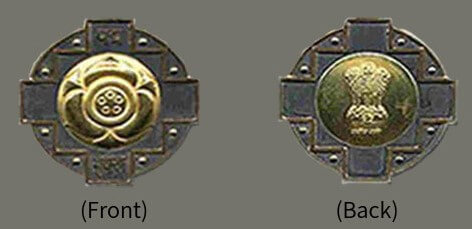
It is also a circular-shaped award which is made of bronze. A lotus flower with the word "Padma Bhusan" has been imprinted on its front side in the Hindi language. Whereas, on the backside, the national emblem and the words "Satya Meva Jayate" have been imprinted. It is provided with a white striped purple ribbon. Besides this, burnished bronze is used in the making of words, geometric pattern, and the border, while the rest of the medal is made of yellow gold. iv) Padma Shri:Last but not least, it is the fourth-highest civilian honour conferred by the government for excellent services or performance of the highest order in any field. Design of Padma Shri: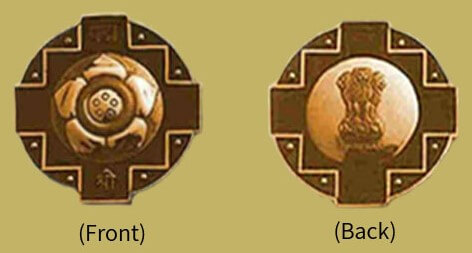
In this medal, the geometric pattern is given on both sides of the medal, which makes it different from the other Padma medals. On its front side, one can see the words "Padma Shri" and a lotus flower carved on it. However, on its reverse side, the national emblem has been carved out. As it is worn around the neck, a white-grey striped purple coloured ribbon is attached to it. 2) Gallantry Awards:The awards in this category belong to Indian soldiers. These awards are conferred to Indian soldiers for their exceptional valor, dignity, courage, and sacrifice. Initially, there were only three gallantry awards: Param Vir Chakra, Maha Vir Chakra and Vir Chakra that were introduced by the government on 26 January 1950. Afterwards, the Govt. of India introduced few more gallantry awards on 4 January 1952, which include Ashoka Chakra Class-I, Ashoka Chakra Class II, Ashoka Chakra III, however, In January 1967 these awards were renamed the Ashoka Chakra, the Kirti Chakra, and the Shaurya Chakra, respectively. The Gallantry Awards are divided into two categories: War Time Gallantry Awards and Peace Time Gallantry Awards. War-Time Gallantry Awards:These awards are instituted for the Indian soldiers who show exceptional valor, courage in the war while fighting the enemy. These awards can be of the following types: i) Param Vir Chakra:It is the most renowned war-time gallantry award presented to a solider for showing outstanding fighting skills, and courage on the battlefield. This award was introduced on 26th January 1950. The word "Param Vir Chakra' means "Wheel of the Ultimate Brave." Design of Param Vir Chakra: 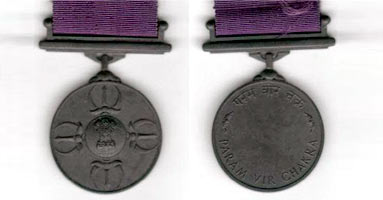
Savitri Bai Khanolankar has designed the Param Vir Chakra. It is made of bronze and is in the form of a circle with a diameter of 1.4 inches. The award suspends from a bar. On the front side, it carries four replicas of Indra's Vajra, which encloses the national emblem. On the backside, it has the words "PARAM VIR CHAKRA" embossed in Hindi and English languages. Between the Hindi and English words, one can see a lotus flower on each side. Major Somnath Sharma was the first army personal to receive the Param Vir Chakra in 1947. He received this award posthumously (after death) for his act of bravery in the Kashmir battle in November 1947. ii) Maha Vir Chakra:It is the second most prestigious war-time gallantry award. It is awarded to Indian soldiers and officers for their enthusiasm and act of courage while facing or fighting the enemy in the war, whether on land, sea or in the air. Design of Maha Vir Chakra: 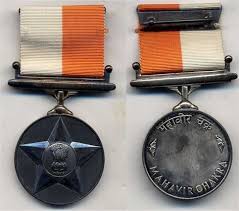
The award is made from standard silver and is circular in shape with a diameter of 1.4 inches. On the front side, a five-pointed heraldic star is imprinted, and the state emblem with the motto is embossed on the domed central-piece. On its opposite side, "MAHA VIR CHAKRA" is written in two different languages (Hindi and English). The words in Hindi are separated from the words in English by lotus flowers. The medal is provided with a ribbon, which is half-white and half-orange. iii) Vir Chakra:It is the third-highest war-time gallantry award presented to soldiers and army officers for the act of bravery while facing or fighting the enemy in the land, sea, or in the air. Design of Vir Chakra: 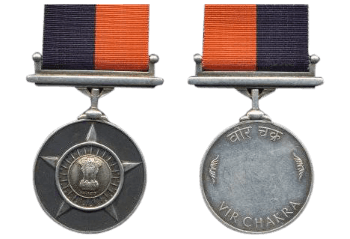
Like other gallantry awards, it also has a circular shape with a diameter of 1.4 inches. It is made of standard silver and has two sides like other awards; on the front side, you can see a five-pointed heraldic star and the state emblem along with motto at the centre, whereas, on the reverse side, there are two words "VIR CHAKRA" written in Hindi and English and separated by a flower on each side. The medal comes with a ribbon, which is blue and half-orange in colour. Peace-time Gallantry Awards:As the name suggests, this category of gallantry awards are awarded to Indian military personals for courageous action or self-sacrifice during the non-war time or away from the battlefield. These awards are of the following types: i) Ashoka Chakra:It is the most prestigious peacetime gallantry award that is awarded to a soldier or army officers for their outstanding valor, courage, and self-sacrifice away from the battlefield. However, a civilian can also be considered eligible to receive this award for his or her selfless courage and self-sacrifice for the country. Design of Ashoka Chakra: 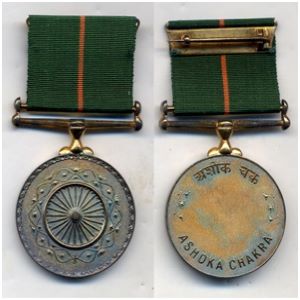
The design of the Ashoka Chakra is very appealing. It is made in the form of a circle whose diameter is 1.4 inches. On the front side, it has a replica of Ashoka Chakra encircled by a lotus garland. On the rear side, the words "Ashoka Chakra" are imprinted in English, and Hindi language and a lotus flower are imprinted between them on each side. The medal is provided with a dark-green silk riband of width 3.2 cm. An orange vertical line divides the riband into two equal parts. It is worn on the left side of the chest along with other medals, if any. The first army personal to receive this honor was from the Indian air force, Flt. Lt. Suhas Biswas in 1952. ii) Kirti Chakra:It is the second-highest peacetime gallantry award presented to an army personal for an exceptional act of bravery, courage, and self-sacrifice. Civilians can also be nominated for this award. Design of Kirti Chakra: 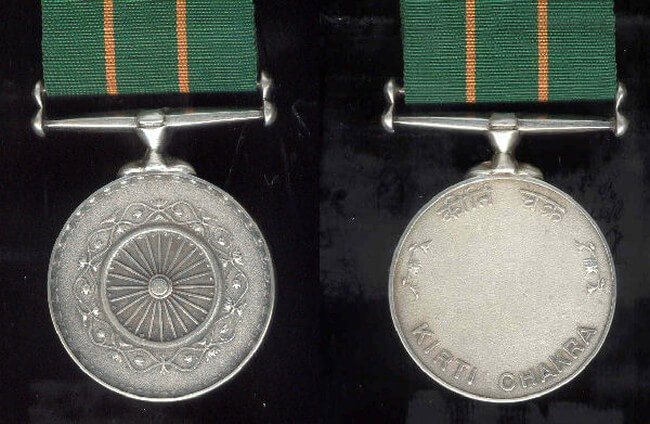
Its shape is like a circle whose diameter is 1.38 inches. It is made of silver and has rims on both sides. A copy of Ashoka Chakra enclosed by a lotus wreath is present in the centre of the front side of this award. On the backside, it is imprinted with words "Kirti Chakra" in English and Hindi. The words are separated by a lotus flower on each side. The medal is provided with a green riband that measures 3.2 cm in width. Two orange vertical lines divide the riband into three equal parts. Like other medals, it is also worn on the left side of the body. iii) Shaurya Chakra:It is the third most prestigious peacetime gallantry award that can be awarded to an army personal as well as to a civilian for an act of bravery or self-sacrifice during peacetime or away from the battleground. Design of Shaurya Chakra: 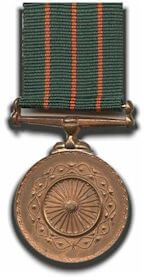
It is also circular in shape with a diameter of 1.4 cm. It is made of bronze with a front side similar to Ashoka Chakra and backside imprinted with "Shaurya Chakra" in Hindi and English and separated by lotus flowers. It is worn on the left side of the chest as it is provided with a 3.2 cm wide riband that is divided into four equal parts by three orange vertical lines. 3) National Sports Awards in India:As the name suggests, these awards are presented to sportsmen for their outstanding performance and excellence in sports. They are national-level sports awards given by Indian Govt. each year. The most renowned national sports awards are described as follows: i) Rajiv Gandhi Khel Ratna Award: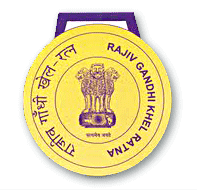
It is the most prestigious national sports award that a sportsperson can get from the Ministry of Youth Affairs and Sports in India. This award is named after the late Prime Minister of India, Sh. Rajiv Gandhi to honour him. It was introduced in 1991 in order to appreciate and boost the morale of the sportspersons in India. The recipient of this award gets a cash prize, a medal, and a certificate. The famous chess player, Vishwanathan Anand became the first sportsman to receive the Rajiv Gandhi Khel Ratna Award for his performance and achievements in chess from the year 1992 to 1993. The first sportswoman to receive this award is Karnam Malleswari in weightlifting. Besides this, Sachin Tendulkar received this award in 1998 for Cricket, and the other cricketers to receive this award are M.S. Dhoni in 2008 and Viral Kohli in 2018. ii) Arjuna Award: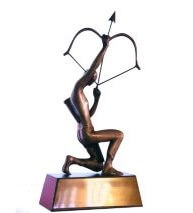
Arjuna Award was introduced in the year 1961, which makes it the oldest national sports award in India. It is conferred by the Ministry of Youth Affairs to sportspersons who have consistently given outstanding performances for at least four years in a row in national and international games. The award is named after Arjuna, a famous archer in the Mahabharata. The awardee gets a bronze statue of Arjuna and a certificate along with a cash prize. There are a total of six first recipients of the Arjuna award in 1961, namely Saleem Durrani in Cricket, Sarabjeet Singh in Basketball, Manuel Aaron in Chess, Gurucharan Singh Randhawa in Athletics, Nandu Natekar in Badminton, and LB D'souza in Boxing. iii) Dronacharya Award: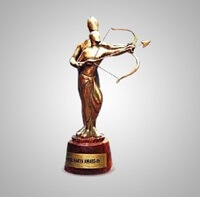
This award is not for the players. It is for the coaches who train and prepare and guide the players to achieve big in sports. Dronacharya Award was introduced in 1985 by the Indian Govt. It is named after "Dronacharya," who was the teacher of Pandavas in Mahabharata. It is awarded to coaches for their efforts, training, and guidance in producing medal winners for the country in national and international level sports events such as the Olympics, commonwealth games, etc. In this award, the recipient gets a statue of Dronacharya, which is made of bronze, a scroll, a ceremonial dress, and a cash prize. The first recipients of the Dronocharya award in 1985 include Bhalachandra Bhaskar Bhagwat (a wrestling coach); O.M. Nambiar (an Athletic coach), Om Prakash Bhardwaj (Boxing coach). Furthermore, the first foreign coach in India who received the Dronacharya award is B.I. Fernandez. IV) Dhyan Chand Award:
It is the most prestigious sporting award that is conferred annually by the Ministry of Youth Affairs and Sports for lifetime achievement. In 2002 the award was named after the Dhyan Chand, a hockey legend of India who scored more than 1000 goals in his hockey career of 20 years. This prize comprises a shield, a certificate, and a cash prize. The first recipient of the Dhyan Chand Award is Aparna Ghosh in the field of Basketball. The awardee for this award are selected after considering their contribution to sports during their sport career and after their retirement. 4) Literary Awards in India:Literary Awards, as the name suggests, are presented to Indian writers to recognize and appreciate their great work of literature and their contribution to the upliftment of the literature in India. It is a great initiative to promote literature and highlight the achievements of writers in literature. The literature work should be in an officially recognized language of India, including the English. There are many literary awards in India that are as follows: i) Jnanpith Award: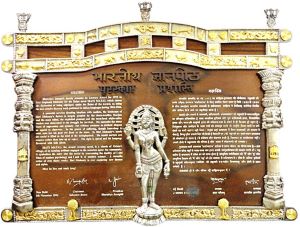
It is the most renowned literary award in India. It is also known as Gyanpeeth Award. It was introduced in 1961 and was awarded by the Gyanpeeth Trust to Indian writers for their outstanding work and contribution to literature in any of the recognized languages of India. The awardee gets a bronze made statue of Goddess Saraswati along with a cash prize. The first writer to receive the Jnanpith Award is Sankara Kurup for his Malayalam poem collections "Otakuzhai" in 1965. The award is not presented for a single piece of writing; the nominees are selected based on their lifetime achievements. ii) Sahitya Akademi Fellowship: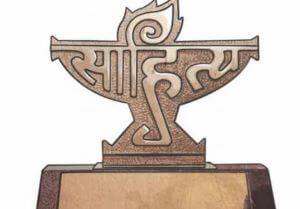
It is the second most renowned literary award in India for the Indian writers for their immortal literature work in any officially recognized language of India. It was introduced in 1968 and is conferred by the National Academy of Letters of Govt. of India, the Sahitya Akademi. In this award, the Akademi elects the awardee as its fellow. The first recipient of Sahitya Akademi Fellowship was Dr. Sarvepalli Radhakrishnan, a statesman, and philosopher. iii) Sahitya Akademi Award:It is the third most renowned literary award in India in the field of literature. It is also conferred by Sahitya Akademi that instituted it in 1954 to recognize and honour the writers for their work of literary merit in any of the officially recognized languages of India. The awardee gets a box containing a copper plaque and a shawl, including a cash prize. Makhanlal Chaturvedi is the first recipient of the Sahitya Akademi Award for his book "Him Tarangini" in 1955. |
 For Videos Join Our Youtube Channel: Join Now
For Videos Join Our Youtube Channel: Join Now
Feedback
- Send your Feedback to [email protected]
Help Others, Please Share









